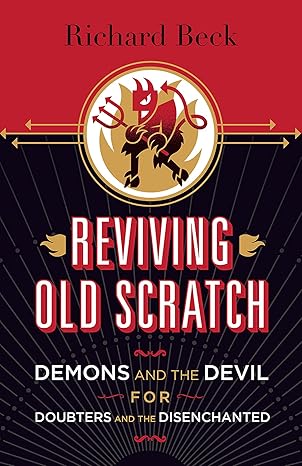Tonight, we will discuss Chapter 3, “Jesus the Exorcist,” and Chapter 4, “The White Witch,” of Richard Beck’s book Reviving Old Scratch: Demons and the Devil for Doubters and the Disenchanted.
Atonement Theory, Generally:
Atonement Theory is one of my favorite topics. Basic Christian doctrine holds that through his Incarnation, Passion, and Resurrection, Jesus caused God and humanity to be reconciled. In his English translation of the Scriptures, the English Reformation scholar William Tyndale (1494-1536) coined the term “atonement” (literally at-one-ment) to describe this reconciliation. Down through the ages and across different cultures and languages, the question arises as to the mechanics of why Christ’s Incarnation, Death, and Resurrection somehow restores our right relationship with God. The answer to this question is known as “atonement theory.” Beck summarizes these theories in his blog post “Atonement Primer.” Please read Beck’s post. (Other summaries can be found HERE and HERE.)
Penal Substitution and Christus Victor:
The prevailing atonement theory in most Protestant churches is penal substitutionary atonement, which generally holds that our sins must be punished by God’s wrath and that Christ substituted himself for us on the Cross and took that wrath on himself. God’s wrath having been satisfied, we can now be at-one with God.
Beginning in 1930 with Gustaf Aulen’s book Christus Victor: A Historical Study of the Three Main Types of the Idea of Atonement, the Protestant Church began a re-evaluation of penal substitution. In the book, Aulen argues that both in the Scriptures and in the early Church, the predominant understanding of the atonement was that, in his death, Jesus was ransomed over to Satan on our behalf and in his resurrection, he obtained victory over Satan, death, and evil. Jesus did not suffer and die because of God’s wrath but because of evil’s claim on a sinful humanity. The satisfaction of Satan’s claim on us and Christ’s victory over Satan means that now we can be at-one with God.
As Beck points out, the Christus Victor model has certain advantages over Penal Substitution. For example, if God must be satisfied and our accounts balanced, then there is no room for love, mercy, or grace. God has been fully paid off. Also, in the Sermon on the Mount, Jesus repeatedly teaches that we must love our enemies, dispense with an eye-for-an-eye, and forgive others. The Christus Victor model is more in line with Jesus’ teachings.
Penal Substitution works very well in a disenchanted world because it only requires a belief in God. We sin, sin needs to be punished, and Jesus takes that punishment. The Christus Victor model, however, requires a robust belief in the reality, power, and jurisdiction of evil. We are imprisoned and overcome by sin/Satan/evil, and that evil must be paid off and destroyed. Christus Victor requires an enchanted understanding of the world.
The White Witch:
Hopefully, you know the story of The Lion, the Witch, and the Wardrobe. The Lion, the Witch, and the Wardrobe. Briefly, the four Pevensie children discover the land of Narnia, which is ruled by the White Witch. Narnia is a place where it is always winter. The first child the White Witch meets is Edmund Pevensie, and she tempts him into betraying his siblings. But with the approach of Aslan, her magical winter thaws. Edmund realizes his sin of betrayal and recognizes the evil of the Witch. Edmund returns to be with his siblings, who are now with Aslan.
The White Witch comes into Aslan’s camp to claim Edmund as hers under the rules of the deep magic, which states that all traitors belong to the Witch. To save Edmund, Aslan gives himself over to the White Witch to suffer the death at her hands that Edmund should be suffering.
The White Witch gladly kills Aslan, thinking that this secures her rule. However, the deeper magic provides that if a willing, innocent victim offers his life in a traitor’s stead, he will be resurrected. Aslan is resurrected and destroys the White Witch and her followers in the final battle.
Beck’s point in using Lewis’s story is to show the centrality of evil personified in a Christus Victor model and that Jesus’s death and resurrection are necessary.
Personal Bias:
On a personal level, Aulen’s book is one of the five most influential theological works that I have read. (Aulen was a Lutheran bishop and argued that Martin Luther had taught Christus Victor.) In my rejection of penal substitutionary atonement, my faith, understanding, and relationship with God has deepened exponentially. God no longer wants to (or has to) send me to hell because I subjectively do not believe the right way or failed to say the right magic words. (I did go to one too many youth summer camps.) Rather, God oversees the mission to rescue me from captivity to sin and death. God’s work is an objective fact and is not dependent upon my subjective acceptance. I do recognize that many other Christians have found great solace in the alternative.
As an aside, I had the opportunity to preach this Sunday at St. Anne’s. The sermon’s topic was John’s Revelation and Christ’s Victory over Satan, et.al. The text and video of the sermon are HERE.
Dinner is at 6. The menu is shepherd’s pie. Discussion about 6:45. Compline at 8. Hope to see you here!
Christ’s victory is the overcoming of the law, sin, our flesh, the world, the devil, death, hell, and all evils. This victory he has given to us. Martin Luther, Commentary on Galatians, p.30.

